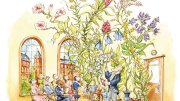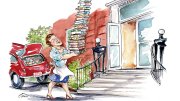1901
J. P. Morgan signifies his intention of donating $1 million toward the construction of new buildings at the Medical School. Grateful administrators cable their thanks to the financier, who is traveling in Europe: “Great gift received: beneficent results innumerable.”
1931
The Law School announces the inauguration of a training course for prison wardens.
Before leaving to take on the world, the seniors offer some suggestions to the University. Among them: that varsity athletics be confined to the freshman, sophomore, and junior years, and that “radical improvement be made in the ventilation of Widener Reading Room (temperature 90 in the shade).”
1946
The Bulletin’s Undergraduate columnist, Mitchell Goodman ’45, reports that The Harvard Crimson has called for a local buyers’ strike as rising prices in the Square make subsistence difficult for fixed-income veteran scholars who receive only $15 a week of government subsistence. A front-page editorial in the paper declares, “What was once proudly called the G.I. Bill of Rights has become a fraud: Existence on $65 a month—or $90 with dependents—is patently impossible.”
1971
The Summer School celebrates its centennial year. Harvard’s first regular summer course, in botany, was offered by Professor Asa Gray; many of his students were women teachers who thus became pioneers in the education of women at the University.
1981
During the summer Alumni College program, 171 people sign up for a week-long course in “basic computer conversation,” which, by its close, has most of them programming.
2006
Crews remove the grass on the Harvard Stadium’s playing field during the summer, replacing it with a new synthetic surface, a $5-million project that will open the stadium for night, winter, and off-season use.








